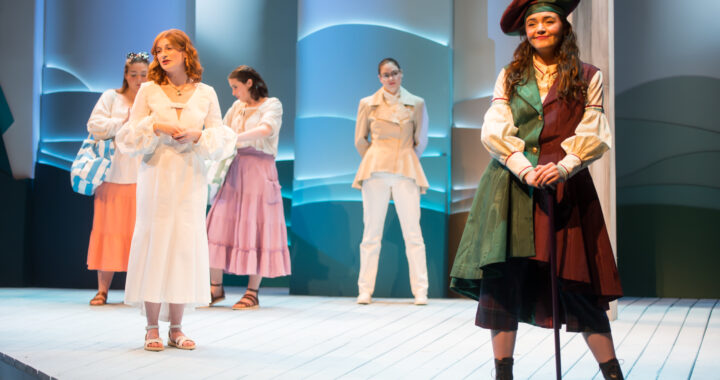Art Professor 'Neutralizes' Illness
4 min readBY TIFFANY DOUGLASS
Joseph Di Bella is celebrating more than his 30-year career in UMW’s Art Department. After suffering a life-threatening illness that kept him out of the classroom in Fall 2006, he is back at the drawing table, literally, reinventing himself as an artist.
Di Bella, 57, was first diagnosed in 2002 with Autoimmune Disease, a hyperactive immune system deficiency. He recovered from his first bout with the illness five years ago, but was forced to take a medical leave last fall when he suffered a relapse.
Di Bella said he was too exhausted to do much of anything during those months besides sleep. He lost more than 50 pounds, and said he could tell the severity of his condition by people’s reaction to his appearance.
“We are still unsure of how exactly I contracted this sickness,” he says. “Possibly genetic, bacteria triggered, who knows.”
One of the worst aspects of the illness was that it kept Di Bella out of his studio, and even when he came back to work last spring, he struggled, taking naps between classes in his office to help him regain energy.
“I now feel much more physically and intellectually better to make art,” he said recently, “whereas before I couldn’t even pick up a paint brush.”
Di Bella said he had plenty of time during his illness to “assess what life really is”—and to recommit himself to continuing his work as an artist. “You appreciate the fragility of life and do what you can while the time is good,” he said.
Since last May, Di Bella has been working on a series of 51 paintings currently on display in duPont Gallery as part of a Faculty Studio Art Exhibition. He says there are significant differences from his work of five years ago.
“Previously, I was interested with abstraction, fusing cultural influences and ethnic backgrounds,” he says. While Di Bella’s cultural and ethnic influences, especially his Sicilian heritage, are still evident in his work, the paintings he has been working on lately are less abstract and more representational.
“Neutralized,” his 51-piece portrait series, is an engaging study of the faces of American soldiers who have died in the Iraq War. Di Bella chose the soldiers based on their last names—names such as White, Brown, Gray, Ivory, Black—because, he says, he saw them as “connoting a neutral pallet”—a metaphor for the way all soldiers’ identities are neutralized after death.
Di Bella based his portraits on photographs of the deceased soldiers published in a section of the New York Times, “Faces of the Dead.”
He said it was partly his own illness that drew him to the theme of soldiers’ identities after their deaths. “I spent all that time dwelling on identity. My own body, after all, was its own enemy,” he says.
He also found inspiration from the challenge of trying to make a “statistic” of death back into an individual through his art.
Di Bella’s biggest question, as he began his project, was “How do I make a statement of life—of these young people— in the Iraq War that reflects this war vs. all wars vs. all life?”
One answer was his decision to use unorthodox materials in his mixed media portraits.
One ingredient was red lily pollen, which Di Bella described as “a staining device of potential fecundity, suggesting life, when these soldiers will never be able to reproduce.”
Another was olive oil, often used for anointing the dead during Last Rites.
He also employed gold point, a filament that does not tarnish or fade over time. Di Bella used that in juxtaposition with silver point which becomes darker with age and erodes—suggesting the decomposition of his subjects after they were killed.
Di Bella also used ash from burnt incense, which is often associated with the ritual of baptism.
All of the portraits are distorted in some way, Di Bella said, symbolizing the impermanence of physical being.
“In art, the aesthetic can be celebrated, but sometimes the ugly is the truth that can be addressed,” he says.
Besides the portraits of the fallen soldiers, Di Bella also included a triptych of paintings in the faculty show—a smaller portrait of himself between two much larger portraits of his sons—Mark, a school administrator in Texas, and Phillip, currently stationed in Iraq on his second tour of duty.
Di Bella wanted to emphasize his sons’ vitality as they enter the prime years of their lives, while at the same time he is forced to recognize to the possibility of another relapse and the further disintegration of his health.
Di Bella says he is pleased with his recent projects and also happy to be back in the classroom. “I haven’t peaked yet [as an artist],” he says. “I take pride in my teaching and there’s always new stuff and people.”
The job of teaching, he says, has gotten better over the past three decades. “You know you’ve made a difference in the lives of your students when they keep in touch with you for 30 years,” he says.
“They’ll always be twenty-two years old in my mind though.”
Di Bella says he doesn’t plan to retire until he turns 65, in eight years—unless his health prevents him from continuing to teach.
“I’m doing what I love to do,” he says. “I have the opportunity to be an encourager, and the ability to have a career to do my passion.”











